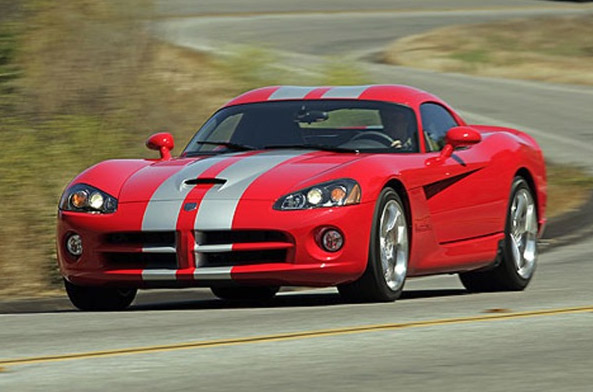Flashback Fridays: 2006 Dodge Viper SRT10 Coupe
Story by John LeBlanc
PASADENA, Calif. – Since my very first ride as a passenger in the then- novel Dodge Viper Roadster back in 1992 — when a local dealer/friend oversteered a pre-sold car into a cornfield — I’ve always held a well-earned level of respect for Dodge’s snake that could easily bite back.
Inspired by Carroll Shelby’s bare- bones Cobra Daytona from the 1960s, the original Viper, with limited creature comforts, outlandish style and Ferrari-challenging performance numbers, became a legend in itself. That legend only grew larger with the introduction in 1996 of the hardtop Viper GTS Coupe. Viper Nation and racers alike quickly embraced it.
“Demand for a Viper coupe started the day we introduced the third- generation convertible in 2003,” says Dan Knott, director of Street and Racing Technology (SRT), Chrysler Group. Having recently partnered with Driving’s Graeme Fletcher in a Chrysler 300C SRT8 at this year’s Targa Newfoundland rally, Knott knows a thing or two about making production cars go fast. Common procedure says you lop off the top of a coupe to make a convertible. In the case of the new Viper Coupe, Dodge started with the existing Viper Roadster. No structural changes were made to the Roadster — it has a stout chassis to begin with — so engineers simply added a hardtop, making the Coupe version 30% stiffer in the process.
To illustrate how important it was to get the new Viper Coupe just right with its existing owner base, at one point, says Knott, a pre-production Coupe was secretly shown to a bunch of Viper club members in Texas.
“They wanted a more aggressive rear spoiler, a steeper angle to the back window and the rear fenderwork to wrap around the tail lights, just like the original ’96 GTS,” he says.
SRT engineers took their advice. The end result is an increase in downforce and high-speed stability over the Roadster, with only 9.07 kilograms of additional curb weight. Compared with the previous- generation Viper GTS Coupe, the new Coupe’s stiffer chassis allows for a more relaxed ride setup. This was evident during the morning drive that took us from Pasadena, Calif., over the San Gabriel Mountains via the twisty, two-lane Angels Crest Highway, eventually dropping us on to the floor of the Mojave Desert.
Granted, weekend antique-hunting trips to New England would still be less tiresome in a Chevrolet Corvette or a Porsche 911. But the Viper — especially the competition-bred Coupe — has always been about providing the ultimate in performance and intimidating the hell out of every other car on the road or at the track.
Once you’ve made sure not to burn your leg on the lower doorsill that sheaths the side-exiting exhausts, getting into the low-slung Viper Coupe is pretty easy. The double-bubble roof is a bit tight, especially with the afternoon lapping’s mandatory helmet. Otherwise, the interior is roomy once one is settled into the supportive bucket seats. The only difference from the Roadster is the extra trunk space — four more cubic feet, bringing the total now to 6.25 cu. ft., accessed via the back hatch.
Push the big, red “Engine Start” button and the familiar rumble of the hulking mill fills the cabin. With the same 500 horsepower, 525 pound-feet-of-torque, 8.3 litre V10 engine as per the Viper Roadster, Dodge claims zero to 96 kilometres an hour in less than four seconds. The more important zero-160-zero km/h in the low-12 seconds claim seems credible and incredible all at the same time. Whether you’ve previously spun out in a Viper or not, this very powerful, rear-drive sports car demands respect, especially when you’ve been handed the keys to a new Viper Coupe for an afternoon of hot-lapping at a track known as the fastest in the United States — Willow Springs International Raceway.
Knott’s SRT gang has reworked the Coupe’s four-wheel independent suspension using lightweight, high-performance aluminum control arms and knuckles, damped by lightweight coil-over shock absorbers. It’s remarkably stiffer than the last generation, to the point where the car’s reactions are noticeably race car quick. Where before you could lazily toss the Viper into a corner, in the ’06 Coupe, you really need to get your braking done in a straight line, balance the car properly and then turn in. As with Vipers before, there are no electric nannies such as traction or stability control to bail you out. Get it wrong and the Coupe’s rear end will swing around quicker than you can cry, “Mommy!”
Another challenge is the Viper Coupe’s mandatory six-speed manual transmission. The gates are close, so shifts need to be careful and deliberate for fear of an inopportune downshift. With 90% of the torque available from 1,500 to 5,600 rpm, I just left the transmission in third gear for most of my lapping. At the end of Willow Spring’s fast, front straight, you are met with a sharp, left-hander, so the Viper Coupe’s Brembo dual- opposing piston calipers, gripping 14-inch rotors, plus an anti-lock braking system, were all very much appreciated, hauling this bad boy down confidently, even after several hours on the track.
Some critics viewed the previous-generation Viper as the automotive equivalent to Harley-Davidsons: loads of character, but technically relatively inferior performing machines.
Er, nix that.
Knott’s engineers at SRT have created a race-ready street car. The new Coupe is the Viper for those lap dogs who know the difference between a decreasing- radius turn and a pothole in the pavement. The only hurdle to hours of lapping fun may be the new Viper Coupe’s $128,500 price tag. Especially with the new Corvette Z06 starting at $89,900. If you’re still interested, just make sure to check for any unwanted cobs of corn before taking delivery of your 2006 Viper SRT10 Coupe.






![[del.icio.us]](https://www.straight-six.com/wp-content/plugins/bookmarkify/delicious.png)
![[Digg]](https://www.straight-six.com/wp-content/plugins/bookmarkify/digg.png)
![[Facebook]](https://www.straight-six.com/wp-content/plugins/bookmarkify/facebook.png)
![[Google]](https://www.straight-six.com/wp-content/plugins/bookmarkify/google.png)
![[Reddit]](https://www.straight-six.com/wp-content/plugins/bookmarkify/reddit.png)
![[StumbleUpon]](https://www.straight-six.com/wp-content/plugins/bookmarkify/stumbleupon.png)
![[Twitter]](https://www.straight-six.com/wp-content/plugins/bookmarkify/twitter.png)
![[Email]](https://www.straight-six.com/wp-content/plugins/bookmarkify/email.png)